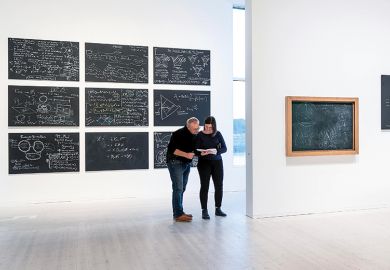“We do the research,” said the biomedical scientist blithely, “and then we get the artists to do the fun bit at the end…”
This vision of academic collaboration – delivered at a conference on the life sciences – is a familiar one: the academic is the expert, and the artist a “fun” disseminator. But it is just one of the many misunderstandings underpinning some of the collaborations and partnerships that have been sought so enthusiastically by the UK higher education sector in the past 15 years.
The notion that art is always fun would, of course, be strongly disputed by many performance artists – not to mention Samuel Beckett. The disseminator model also falsely presumes that artists are without expertise of their own: they are imagined as empty vessels, through which academics – the senior partner in the power relationship – can tell the world about their research.
The result is that collaborations between artists and academics can sometimes proceed on the basis of mutual incomprehension and painful misunderstandings. One physicist confessed to having felt deeply hurt when his collaborator, a visual artist, produced an artwork that responded to the decor in his office building, rather than translating his beautiful mathematical ideas into art, as he had expected. Only later did he come to realise that the job of artists is not to translate or disseminate another’s ideas, but to pay attention to the marginal, the unexpected, the least likely versions of the world and to translate them into art. This counts as expert knowledge too – but it is knowledge that takes a different form to academic research.
This problem of collaboration is one we might need to consider urgently in the face of the crisis that now looms over the arts after months of being closed to audiences. Freelance arts workers, already the denizens of the original gig economy, will be even more vulnerable to exploitation given the inevitable and violent shrinkage of their industries.
Universities will offer some opportunities for work and support where there is little available elsewhere. And so they should. But, in reality, their motives are not always entirely honourable. The UK’s impact agenda has resulted in the higher education sector assuming a vampiric role, sucking up the prestige of arts organisations and individual arts workers in order to demonstrate the public benefit of their research.
In the best cases, this can be a genuinely transformative and mutually beneficial relationship. The exchange of academic expertise with arts workers, built on a recognition of the alternative paradigms offered by each participant, means that knowledge can circulate in new and changed ways. But there have been ongoing and justified rumblings of concern within the arts at the commonplace expectation that artists – who don’t have salaries – should offer their services for free when asked to take part in panel discussions, attend conferences, advise on research, or participate in interviews. After all, the implicit thinking goes, if art is fun then surely those doing it hardly require fair payment?
Equally, university managers can be inclined to think of the arts and cultural sector as “industry” and therefore presume that partnerships and collaborations will automatically bring in income – which they generally don’t. The arts and creative economy might be worth more than £100 billion to the UK economy, but the benefits rarely accrue directly to the people creating the work. It’s the hoteliers, restaurateurs and taxi drivers who are the greatest beneficiaries of the theatre scene in London’s West End, for instance. Arts organisations will help to attract funding, but they are unlikely to bring any money with them to the relationship. Conversely, arts organisations, operating on a shoestring, often assume that universities can provide endless funds – which, particularly in a post-Covid world, is less and less the case.
Furthermore, both parties can become addicted to the excitement of continually initiating new projects – clutching warm white wine and making speeches – rather than focusing on how to sustain existing ones three years in, when everybody is bored and tired.
Such work should certainly continue. But it must do so for the right reasons, and in full knowledge of what each party can offer. At their best, partnerships with the arts see universities functioning as a genuinely public resource, offering expertise and support as equal partners in an exchange that benefits from the alternative paradigms and expertise that artists have to offer.
The result may not always be fun and they may not always inform the public about academic ideas. But they can be revelatory nonetheless.
Aoife Monks is arts and culture academic lead at Queen Mary University of London, which recently launched a support centre for arts workers.
Register to continue
Why register?
- Registration is free and only takes a moment
- Once registered, you can read 3 articles a month
- Sign up for our newsletter
Subscribe
Or subscribe for unlimited access to:
- Unlimited access to news, views, insights & reviews
- Digital editions
- Digital access to THE’s university and college rankings analysis
Already registered or a current subscriber?









